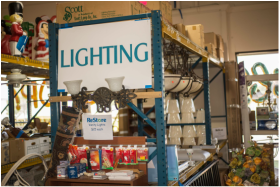|
After six years with Griff's Electric, Kerissa is saying a tearful goodbye to her customers, coworkers and family as she accepts a position with Nature USA.
Kerissa first came to Griff's Electric, Inc. in January 2009 during the tumultuous financial meltdown. With the guidance of her father Griff, the patience from Albert and her coworkers and the notes her grandmother Phyllis left, she began the challenging task of understanding the contracting business and the electrical industry. In 2012 Kerissa decided to go back to school to pursue her Master's in Business Administration (MBA) at CSULB. With the newly acquired skills and the help from her colleague Jody, Kerissa was able to create a marketing and social media program to help customers connect to Griff's Electric online and through their mobile devices. "Working alongside my mom and dad, I learned the importance of service and kindness. After six years here, my colleagues and customers feel more like family then acquaintances. I'm really going to miss all of the friends I've made. I want to thank them for all of the generosity they have shown me. I look forward to helping my new company, coworkers and customers with the same dedication and work ethic that I learned at Griff's Electric, Inc. In fact, my new company Nature USA is family owned and located just under 6 miles away from Griff's Electric's office. I won't be far and as I've told Jody, Albert and my dad, I'm just a phone call away!'
10 Comments
The ports of Long Beach are looking to upgrade to LEP lighting for better vision and to help the light pollution in the surrounding communities. Currently, LED lighting has been the majority of the lighting at the ports. But, the problems with LED's is that they are not bright enough for the work being done. This has caused light pollution in the surrounding areas. Light pollution has become a growing concern around the world because it has negative effects on both the environment and on the circadian rhythm of humans.
Port operators and Southern California hope that using the new light technology will redirect the light to where it is needed and cut energy consumption in half. "LEDs lose their effectiveness the further they are away from the area that needs lighting, which is an issue at the ports, where light poles have to be as high as 140 feet to illuminate the pathways between stacks of containers." LEP lighting will drastically cut down on light pollution in the surrounding area and keep residents happy. For an extra cost, the light fixtures can be fitted with a wireless transmitter that allows port operators to dim lights during off hours to a sixth of their full power. This would save even more energy at the ports. But, only trial and error will truly tell if LEP is the industrial. lighting of the future. For more detailed information, please see the following article: http://www.presstelegram.com/environment-and-nature/20150315/can-plasma-bulbs-solve-light-pollution-problem-at-ports  If you work in the construction trade you know it is inevitable that job materials and building materials will not always be used up 100%. What do you do with the leftover materials? Sometimes you can return the items. Oftentimes you are left to store the unused paint, tiles, or electrical parts hoping that one day a future job will need the exact same parts. Another option is to donate the construction materials to Habitat for Humanity's ReStores. These stores take gently used construction and building materials with 100% of proceeds going to building affordable Habitat homes. ReStore locations are located throughout California. To see a directory of locations go to habitat.org/restores/directory/ca Recyclable Items
How to Donate
LA Area Call (866) 746-7434 or Visit Donatetohabitat.org OC Area Call (714) 434-6202 or Visit ReStoreOC.org |
Categories
All
Archives
April 2020
|
|
Copyright © 2024. Griff's Electric, Inc.
|







 RSS Feed
RSS Feed